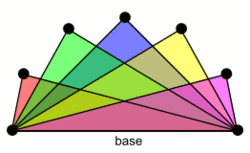Book (graph theory)
In graph theory, a book graph (often written [math]\displaystyle{ B_p }[/math] ) may be any of several kinds of graph formed by multiple cycles sharing an edge.
Variations
One kind, which may be called a quadrilateral book, consists of p quadrilaterals sharing a common edge (known as the "spine" or "base" of the book). That is, it is a Cartesian product of a star and a single edge.[1][2] The 7-page book graph of this type provides an example of a graph with no harmonious labeling.[2]
A second type, which might be called a triangular book, is the complete tripartite graph K1,1,p. It is a graph consisting of [math]\displaystyle{ p }[/math] triangles sharing a common edge.[3] A book of this type is a split graph. This graph has also been called a [math]\displaystyle{ K_e(2,p) }[/math][4] or a thagomizer graph (after thagomizers, the spiked tails of stegosaurian dinosaurs, because of their pointy appearance in certain drawings) and their graphic matroids have been called thagomizer matroids.[5] Triangular books form one of the key building blocks of line perfect graphs.[6]
The term "book-graph" has been employed for other uses. Barioli[7] used it to mean a graph composed of a number of arbitrary subgraphs having two vertices in common. (Barioli did not write [math]\displaystyle{ B_p }[/math] for his book-graph.)
Within larger graphs
Given a graph [math]\displaystyle{ G }[/math], one may write [math]\displaystyle{ bk(G) }[/math] for the largest book (of the kind being considered) contained within [math]\displaystyle{ G }[/math].
Theorems on books
Denote the Ramsey number of two triangular books by [math]\displaystyle{ r(B_p,\ B_q). }[/math] This is the smallest number [math]\displaystyle{ r }[/math] such that for every [math]\displaystyle{ r }[/math]-vertex graph, either the graph itself contains [math]\displaystyle{ B_p }[/math] as a subgraph, or its complement graph contains [math]\displaystyle{ B_q }[/math] as a subgraph.
- If [math]\displaystyle{ 1\leq p\leq q }[/math], then [math]\displaystyle{ r(B_p,\ B_q)=2q+3 }[/math].[8]
- There exists a constant [math]\displaystyle{ c=o(1) }[/math] such that [math]\displaystyle{ r(B_p,\ B_q)=2q+3 }[/math] whenever [math]\displaystyle{ q\geq cp }[/math].
- If [math]\displaystyle{ p\leq q/6+o(q) }[/math], and [math]\displaystyle{ q }[/math] is large, the Ramsey number is given by [math]\displaystyle{ 2q+3 }[/math].
- Let [math]\displaystyle{ C }[/math] be a constant, and [math]\displaystyle{ k = Cn }[/math]. Then every graph on [math]\displaystyle{ n }[/math] vertices and [math]\displaystyle{ m }[/math] edges contains a (triangular) [math]\displaystyle{ B_k }[/math].[9]
References
- ↑ Weisstein, Eric W.. "Book Graph". http://mathworld.wolfram.com/BookGraph.html.
- ↑ 2.0 2.1 "A dynamic survey of graph labeling". Electronic Journal of Combinatorics 5: Dynamic Survey 6. 1998. http://www.combinatorics.org/ojs/index.php/eljc/article/view/DS6.
- ↑ Lingsheng Shi; Zhipeng Song (2007). "Upper bounds on the spectral radius of book-free and/or K2,l-free graphs". Linear Algebra and Its Applications 420 (2–3): 526–9. doi:10.1016/j.laa.2006.08.007.
- ↑ Erdős, Paul (1963). "On the structure of linear graphs". Israel Journal of Mathematics 1 (3): 156–160. doi:10.1007/BF02759702.
- ↑ Gedeon, Katie R. (2017). "Kazhdan-Lusztig polynomials of thagomizer matroids". Electronic Journal of Combinatorics 24 (3): Paper 3.12. doi:10.37236/6567.; Xie, Matthew H. Y.; Zhang, Philip B. (2019). "Equivariant Kazhdan-Lusztig polynomials of thagomizer matroids". Proceedings of the American Mathematical Society 147 (11): 4687–4695. doi:10.1090/proc/14608.; Proudfoot, Nicholas; Ramos, Eric (2019). "Functorial invariants of trees and their cones". Selecta Mathematica. New Series 25 (4): Paper 62. doi:10.1007/s00029-019-0509-4.
- ↑ Maffray, Frédéric (1992). "Kernels in perfect line-graphs". Journal of Combinatorial Theory. Series B 55 (1): 1–8. doi:10.1016/0095-8956(92)90028-V..
- ↑ Barioli, Francesco (1998). "Completely positive matrices with a book-graph". Linear Algebra and Its Applications 277 (1–3): 11–31. doi:10.1016/S0024-3795(97)10070-2.
- ↑ "On Ramsey numbers for books". Journal of Graph Theory 2 (1): 77–87. 1978. doi:10.1002/jgt.3190020110.
- ↑ Erdős, P. (1962). "On a theorem of Rademacher-Turán". Illinois Journal of Mathematics 6: 122–7. doi:10.1215/ijm/1255631811. http://projecteuclid.org/euclid.ijm/1255631811.
 |


